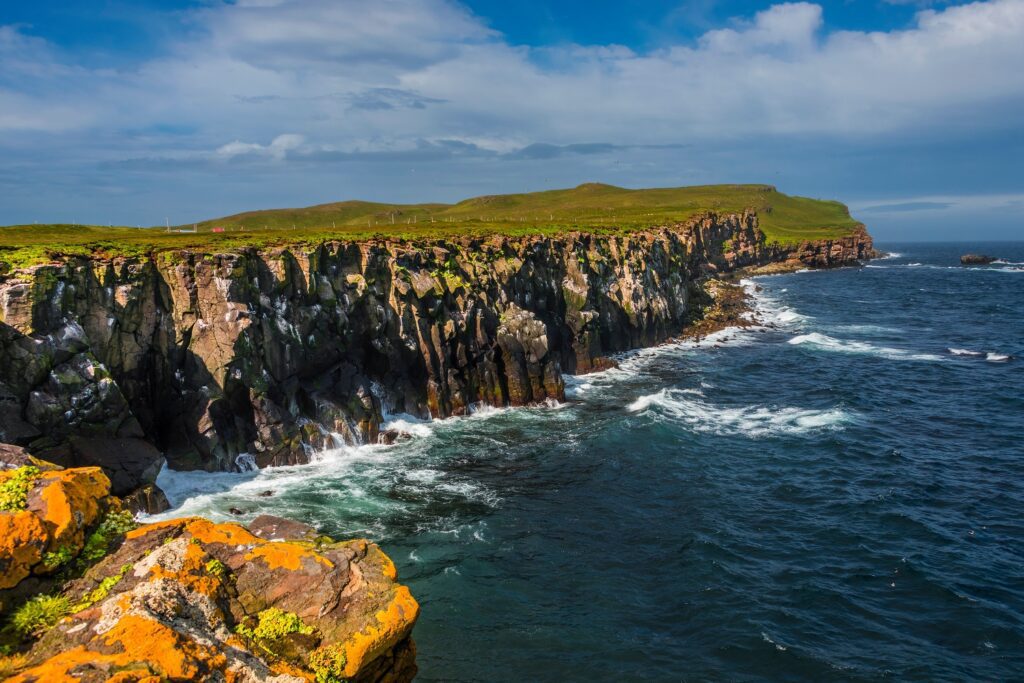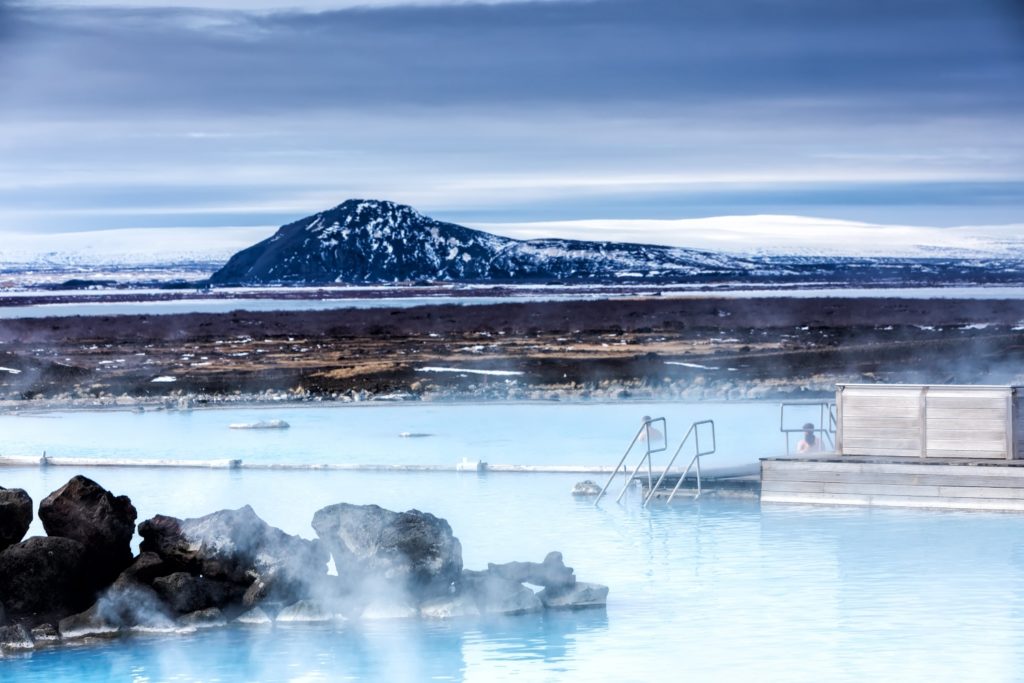If exploring some of our planet’s most remote and unique environments is your kind of travel adventure… read on, as you’ll probably want to add a visit to the Arctic Circle to your wish list.
Along with Finland, Norway, Sweden, Greenland, Russia, Canada, and Alaska – Iceland is one of only eight countries on Earth that have land within the Arctic Circle, so adding a polar encounter to your Icelandic adventure is a real possibility.
What is the Arctic Circle?
Like the Equator, the Tropic of Cancer, the Tropic of Capricorn, and the Antarctic Circle, the Arctic Circle is one of the five major circles of latitude around Earth. It marks the border of the Arctic, the northernmost region of Earth, which covers roughly 4% of Earth’s surface.
The North Pole is the geographical point at the center of the Arctic Circle.
Measuring c.16,000 km in circumference, the Arctic Circle is approximately 66.5° north of the Equator. However, its exact position shifts around 14.5 meters each year, depending on the Earth’s axial tilt, which fluctuates owing to tidal forces resulting from the orbit of the Moon.
The Arctic Circle in North Iceland
Most of Iceland sits just below the Arctic Circle, but at the most northerly points of the mainland, you can drive to the very edge of the Arctic Circle. If you’re keen to cross into this northern polar region, then a trip to Grímsey Island will place your feet firmly inside the Circle – making you a true polar adventurer!
Let’s start there…
Into the Arctic Circle – Grímsey Island

Grímsey is a small 5 km2 island located 40 km off the north Icelandic coast. Less than 100 island residents live in the tiny fishing village of Sandvík – the island’s only settlement.
While fishing is the dominant livelihood, a small tourism hub has evolved on the island, offering accommodation, cafés, a swimming pool, a supermarket, Internet access, and a mini airport – making this a remote yet hospitable destination for a day trip or overnight stay.
Entering the Arctic Circle is just one reason to visit Grímsey. The island also has a thriving seabird population, with around 60 species, including puffins, razorbills, northern fulmars, and arctic terns. Whale-watching trips are also offered, and the impressive basalt column cliffs are well worth exploring too.
Remember to grab your once-in-a-lifetime insta-moment at the Orbis et Globus – ‘the Sphere of the North’ – a sculpture that is a symbol and a landmark for the Arctic Circle. If you want further credentials, then official Grímsey tour operators typically issue a diploma confirming your status as an intrepid polar explorer! If visiting under your own steam, the local souvenir shop can provide similar paperwork.
How to get to Grímsey Island
You can reach Grímsey Island by ferry or plane.
You can leave your hire car on the mainland and catch a Norlandair flight (30 minutes) from Akureyri. Scheduled flights are available all year round, typically on Tuesdays, Fridays, and Sundays.
Alternatively, you can take a slightly longer trip (3 hours) aboard the Sæfari ferry from Dalvík. Again, the ferry operates all year round (weather permitting!) but with a reduced service during the winter months. Please note that if you want to take your hire car, vehicles must be booked in advance, and you must arrive at the ferry one hour before departure.
Akureyri

The ‘Capital of the North’, Akureyri, is the second-largest city in Iceland, and it’s a great place to spend time before or after a trip to Grímsey. Fantastic forest hiking trails, skiing, golf, botanical gardens, and museums are all within easy striking distance with a hire car.
Dalvík
Dalvík is a fishing village located 46 km along the coast from Akureyri. Here, you can enjoy whale watching, skiing, and birdwatching or be tempted by the produce of Bruggsmidjan Kaldi Brewery – Iceland’s first microbrewery!
Touching the Arctic Circle – Hraunhafnartangi and Rifstangi
If you prefer to stay on the mainland, a road trip to the far northeast corner of Iceland will take you within touching distance of the Arctic Circle.
Hraunhafnartangi and Rifstangi are the most northerly points on mainland Iceland and sit on the precipice of the polar zone. At Hraunhafnartangi, snap a photo by the lighthouse to earn a certificate that confirms your success in reaching the northernmost point.
You can also take a moment at Hraunhafnartangi to discover Þorgeirsdys, the assumed burial mound of Þorgeir Hávarsson, a Viking warrior whose tales of daring-do are detailed in Saga of Sworn-Brothers (Fóstbræðrasaga) – part of Iceland’s rich cultural history.
Exploring North Iceland
Alongside a polar encounter, north Iceland has so much more to offer. Remote volcanic landscapes, abundant wildlife, and stunning lakes ensure visitors to the north are in for a treat!
Proximity to the Arctic zone makes the region ideal for experiencing the Midnight Sun in the summer, and the long winter nights provide an ideal stage for the Northern Lights.
If you’re planning a road trip in Iceland, then north Iceland’s Diamond Circle is worth considering as an alternative to busier, more well-known routes, such as the Golden Circle. With plenty of awe-inspiring places to visit, we’ve narrowed the selection down to highlight our top five northern destinations.
Top five must-see places in North Iceland
1. The Arctic Henge

In keeping with the Arctic travel theme, you can visit this impressive new stone monument in Raufarhöfn, one of Iceland’s northernmost settlements. Currently under construction, the Arctic Henge includes stone arches and statues arranged as a monument to Norse pagan beliefs – imagine a modern-day Stonehenge.
At present, you can see four completed large stone arches, which encircle a great central column of four pillars. The arches are positioned to capture the light of the Midnight Sun, and on June 21/22 (the summer solstice), the sun aligns perfectly with the southern arch.
There are plans to add more elements, including a Throne of the Sun, the Hall of Rays, and an Altar of Fire and Water – where rituals, ceremonies, and weddings will take place.
Raufarhöfn is on Iceland’s Melrakkaslétta Peninsula, and the village and Arctic Henge overlook the Arctic Ocean. For insight into Iceland’s sea-faring history, it’s also worth exploring the abandoned buildings in the area, a remnant of its once-thriving herring industry.
2. Ásbyrgi Canyon (Shelter of the Gods)

Ásbyrgi Canyon is a vast 3.5 km long canyon shaped like a horseshoe. Part of the larger Jökulsárgljúfur Canyon and located in the stunning Vatnajökull National Park, Ásbyrgi was formed eight to ten million years ago by catastrophic glacial flooding.
Or was it? Our mythological sources tell us that Sleipnir, the eight-legged horse of the Norse god Odin, created Ásbyrgi. When Odin got too close to Earth, his horse accidentally touched the ground – leaving just one hoof print behind. We’ll let you decide which theory you prefer.
Some visitors claim the canyon has a unique ethereal atmosphere, which is perhaps why it is steeped in Icelandic folklore. It’s suggested that the canyon’s cracks and crevices are home to Iceland’s hidden people (Huldufólk) and elves. We haven’t spotted any elves yet, but the surrounding woodland is home to Arctic foxes – the only mammal native to Iceland.
If you’re keen to spot an elusive Arctic fox, remember that only one-third of Iceland’s foxes sport the iconic white fur; the rest are a brown/grey color – depending on how they blend into their environment. This makes them incredibly tricky to spot without an experienced guide.
But perhaps you’ll catch a lucky glimpse – of either elf or fox…!
The canyon is a fantastic hiking spot, with various trails available. Ásbyrgi is part of the Diamond Circle route, and the easiest way to reach the canyon is by hire car or campervan. It is well-signposted from Road 85, which is open all year round, but do drive cautiously, particularly in winter.
3. Dettifoss and Godafoss Waterfalls

Waterfall chasers can’t resist visiting Dettifoss. Located south of Ásbyrgi, this waterfall is also part of Vatnajökull National Park.
Known affectionately as ‘Raging Falls,’ Dettifoss is considered Europe’s most powerful waterfall – especially in spring and early summer when snowmelt boosts the volume of water.
Godafoss is another spectacular waterfall, which, again, is entwined with local folklore. The story goes that in 1000AD, statues of Norse gods were thrown into the falls when Christianity became the official Icelandic religion – hence the name Godafoss (‘Waterfall of the Gods’).
Both waterfalls are easily accessed by hire car as part of the Diamond Circle.
4. Whale watching at Dalvík
With a 98% success rate for spotting whales, the tours departing from Dalvík in north Iceland are hard to beat. There’s a chance of encountering humpback whales, minke whales, porpoises, dolphins, and even blue whales.
Dalvík is set on Eyjafjörður – the longest fjord in Iceland – which guarantees an epic backdrop to your whale-watching adventure.
Alternatively, you can head to Húsavík, on the bay of Skjálfandi. This colorful little town is fittingly known as Iceland’s whale-watching capital.
Summer (June to August) is the best time for spotting whales, and again, the easiest way to reach Dalvík and Húsavík is by rental car.
5. Geothermal Lake Mývatn

Iceland is a country defined by its contrasting elements. So, what better way to balance out an Arctic experience than a visit to the volcanic landscapes of Lake Mývatn? Created by a volcanic eruption over 2000 years ago, this serene lake is surrounded by lava fields, hot springs, and craters.
With 13 duck species (more than any other lake worldwide), plus pseudocraters at Skútustaðir and lava fields at Dimmuborgir to explore, Mývatn is a paradise for nature and geology fans. You can extend your exploration of this area with a trip to the bubbling pools and hissing geysers of Hverir Hot Springs.
Respite from days on the road can be found at Mývatn Nature Baths, just a short drive from the lake. Described as north Iceland’s alternative Blue Lagoon, this tranquil (far less busy) location is perfect for soaking up the mineral waters while enjoying incredible views.
Extending your self-drive adventure
With the freedom to expand your road trip plans further off the beaten track, perhaps you’ll head into the more remote reaches of north Iceland – from hiking in Jökulsárgljúfur Canyon to puffin-spotting in the Tjörnes Peninsula?

Driving in north Iceland is an unforgettable adventure. But remember, because it’s more remote, there are fewer fuel stops. The northern main roads are in good condition, but not all are paved, so a 4×4 vehicle is recommended if you plan to stray off the Diamond Circle.
And finally… always check the weather conditions before setting off, even in summer! We’re happy to advise on vehicle choice and routes, depending on the time of year you plan to visit.
If you’re still seeking ideas for your self-drive Icelandic adventure, please check out the rest of our blog for more inspiration.
Back